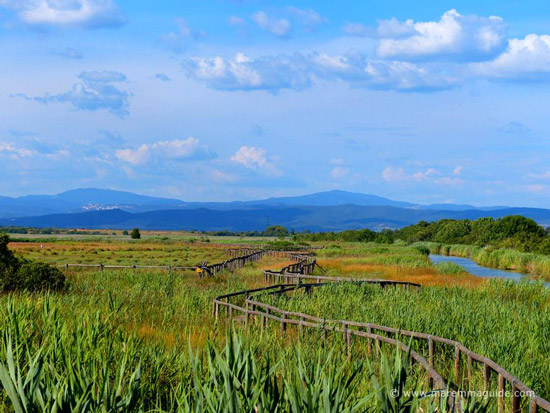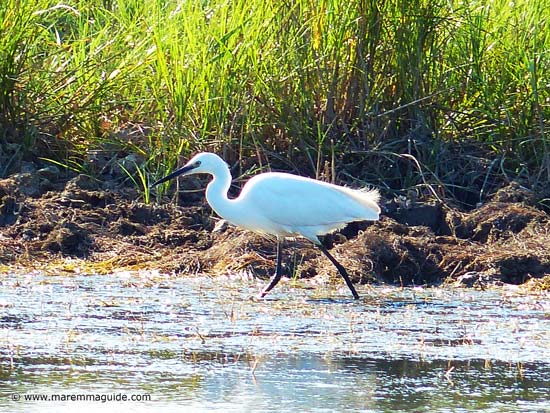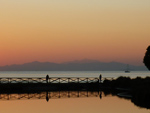The Oasis del Padule di Scarlino
A step back in time to the Maremma of not so long ago
The Padule di Scarlino oasis is one of those places that you could drive past many times and never know it was there. And that is despite its entrance being right alongside the main coastal road in Maremma and directly opposite a very popular and lovely stretch of sandy beach.
Yet a visit to these marshes shouldn't be missed for the array of tiny delights that it holds. If the sparkling flash of the wings of a dragonfly or the twitching nose and "baffi" (whiskers) of a "castorino" (little beaver) munching on its supper are the kind of things that will bring a smile to your face, then this oasis in Maremma is just the place to stop for an hour and a change of pace.
 Oasis di Protezione Faunistica Padule e Costiere di Scarlino
Oasis di Protezione Faunistica Padule e Costiere di ScarlinoOr much longer if you love birdwatching, for it is mainly for its nearly two hundred species of birds that it is a protected site of both regional and community interest.
January 2015 UPDATE
It saddens me to have to report that the heavy rainfall in Maremma at the end of January 2014 and beginning of February 2014 and the subsequent floods have meant the closure of the Padule to human visitors.
The flood waters literally lifted a whole section of the wooden walkway above the wetland and transported it to the other side of the river. That in itself would have probably been easily repairable - "just like Lego" my youngster declared - but the rest of the path also lost its firm foundations and is now very rickety, collapsed, or overturned. The second of the two hides to be found at the end of the path - and my favourite Saturday or Sunday photographing spot - now looks like it had a heavy night out and drank much too much of the local Monteregio di Massa Marittima vino!
I'll update again here when the path is repaired.
What you can spot...
Amongst others, this Tuscany wetland is home to the European Polecat (Puzzola europea), European Pond Turtle (Emys orbicularis) and the European Green Toad (Bufo viridis) - isn't he splendid!
 European Green Toad - Photo by Richard Bartz
European Green Toad - Photo by Richard Bartz
Dizzy with Dragonflies
One of the most captivating natural wonders of the Padule are its many many dragonflies. More than twenty species live here and if you can get used to following their scatty water skipping dances and focus your camera in time you can get some wonderful shots.
I'm still trying to photograph the brilliant shimmering azzuro blue Aeshna mixta ones, but they won't stay still for long enough! The red ones when mating have been more accommodating!
 Dragonflies mating in October
Dragonflies mating in OctoberMating and drinking water on the go...

Lots of Lizards
Take a walk down the path when the sun is out and you'll be greeted by lots and lots of scurrying "Lucertole" - lizards.
 "Lucertola" - lizard - basking in the sun of an October afternoon.
"Lucertola" - lizard - basking in the sun of an October afternoon.And butterflies too.
Falcons
 Two pairs of "Falco di Palude" - Western Marsh Harriers - in October in the marsh with the lovely hill town of Massa Marittima in the distance.
Two pairs of "Falco di Palude" - Western Marsh Harriers - in October in the marsh with the lovely hill town of Massa Marittima in the distance.There are six species of birds of prey living in the Padule: the Falco pescatore (Pandion haliaetus) - Osprey, the Falco lodolaio (Falco subbuteo) - Eurasian Hobby, the Gheppio (Falco tinnunculus) - Common Kestrel, the Poiana (Buteo buteo) - Common Buzzard, the Albanella reale (Circus cyaneus) - Northern Harrier, the Albanella minore (Circus pygargus) - Montagu's Harrier, and the Falco di palude (Circus aeruginosus) - the Western Marsh Harrier, four of which I managed to catch in the distance in the photograph above.
184 other species of birds
 The "Garzetta" - Little Egret
The "Garzetta" - Little EgretFor details of the other Padule di Scarlino birds that you will more than likely be able to spot - the birdwatching in Maremma page.
Cinghiale - Wild boar
The Padule di Scarlino is home to a lot of wild boar. In the early evenings - particularly at dusk - if you are the only ones walking along the footpath, you can practically be guaranteed to hear the sound of noisy pigs close by alongside the path. You will always be able to spot their trails through the reed and their mud bathing areas.

If you don't want a close encounter - whilst they are accustomed to humans being in the wetland, they are still wild animals - make a noise and watch the reeds on the opposite side of the canal bank divide and move as they swim over and disappear. Be a little more courageous, and walk silently and you might get a fabulous photo opportunity .
TIP If you are visiting early evening, take some mosquito repellent with you as some nights you will really need some. Last night I ended-up being the local "zanzare" populations dinner as I tried to photograph that gorgeous and elusive to me blue dragonfly.
Maremmano Cattle

In the southern part of the wetland, on your immediate left where the path starts, where the waters are dominantly brackish, there is a very wet meadow of salicornie (Glasswort), which changes as the salinity decreases further inland from the coast to be dominated by reeds and Scirpus (bulrush). It is here that thirty-eight acres have been fenced off to provide a home for a small herd of Maremmano cattle who graze freely, often close to the pathway.
Something for those who are curious about the little things...

If you happen to visit after the marshes have been flooded - the last two autumns here in Maremma have seen days of torrential flood waters - and the waters have receded sufficiently to be able to walk along the pathway, don't be surprised if you find the pathway littered with black poo along the pathway!
When I first found saw it I thought it was wild boar, but wild boar is more like humans and these droppings are cylindrical and pointed at the ends like a mouse's. So I investigated further and it turns out it is a very big mouse indeed!

When the flood waters start to recede, the only dry land around is the "sentiero" pathway on stilts through the reeds. Which is where the resident Nutria Coypu hang out until the dry upper sections of their homes are liveable in again.
 Nutria or Coypu swimming in the canal of the Padule di Scarlino
Nutria or Coypu swimming in the canal of the Padule di Scarlino
The large numbers of the Nutria and especially Cinghiale - Wild Boar - living in the marshes is putting at risk the natural environment for their nesting and feeding habits destroy the stability of the water plants and wetland terrain.
The video
Access and map

The wetland is accessible by a raised wooden walkway that takes you past a hide and a small pond, to another of both at its centre. From here you can get a good view - if you want one! - of the local landmark of Follonica's waste burning site and its red and white stripped chimney in the distance.
The raised walkway also means that you don't have to have your Wellington boots with you or return home covered in mud, in order to do a spot of bird or wildlife watching. And pushchairs, grannies and granddads, and mountain bikes can come too!
Entrance to the Padule di Scarlino is free and starts at its small car park (also free).
TIP There a large fig tree in the car park: perfect for an impromptu snack!
Disabled access
The whole of the wooden walkway is wheelchair accessible, as are both hides: way to go Scarlino! and my compliments for the forethought.
Note: after the recent heavy rainfalls, the footpath is less than horizontal in couple of places, but is very well maintained and I suspect will be righted very soon. But, in any event, is still readily traversable.
Location map
The satellite map.
A Maremma of the past under threat
Sadly, the future of the Padule di Scarlino isn't secure because of its proximity to areas of intense human activity. The campsites and self-catering apartment complexes on the beach, the village of Puntone di Scarlino with its bars, restaurants and hotels. The port at Portiglione and the brand new Marina di Scarlino. The construction of new holiday homes alongside the edge of the marsh, the high risk of pollutants from nearby industrial plants, intensive hunting activity around its perimeter, illegal dumping and more. A recent fire also destroyed the Padule's last remaining humid woodland.
Added to which are compromising natural factors such as the poor quality of incoming water and insufficient supplies in the summer, increasingly frequent silting of the marsh area when the rivers flood, the spread of invasive reeds, and the damage done to the marsh plants root system by the large number of its burrowing inhabitants.
It would be a pity indeed if the Padule di Scarlino were to slowly disappear. Not only because of the precious natural habitat it provides for hundreds of species, but because it also offers a real taste of what all of the lowland in Maremma was like not so long ago. Before the land reclamations began.
A primitive land that witnessed the hard and short lives of men, women, and children, whose destiny was determined by malaria.
Things to do next door...

And for something else to see before or after, in the car park you will also find the entrance to the tiny new Museo Acheologico di Portus Scabris (MAPS) museum. Well worth a visit for anyone interested in archaeology - especially marine archaeology - as it houses the collection of artefacts dating back to Etruscan times and through the middle ages excavated by underwater archaeologists when the new Marina di Scarlino was constructed.
Still on the same side of the road, heading a very short distance towards Follonica, there is the remains of the Roman Villa of Puntone Vecchio, and then a donkey sanctuary.
Beaches
Directly across the road is the the beach of Puntone di Scarlino. And a short drive and a trek away through the Bandite di Scarlino reserve are the coves of Cala Martina and the very beautiful and famous Cala Violina.
 Puntone di Scarlino beach
Puntone di Scarlino beach
Explore some more...


















